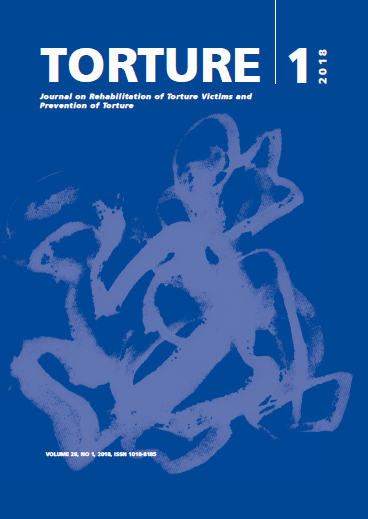Evaluation of the efficacy of a South African psychosocial model for the rehabilitation of torture survivors
DOI:
https://doi.org/10.7146/torture.v28i1.105476Abstract
This paper explores the significance of cultural variations in emotion for the meaning and impact of torture, focusing on the dynamics of shame, humiliation, and powerlessness. Forms of physical and psychological pain and suffering share some common neurobiological pathways and regulatory systems that are influenced by social and cultural factors. All forms of torture follow an affective logic rooted both in human biology and in local social and cultural meanings of experience. Understanding the impact of specific forms of torture on individuals requires knowledge of their learning histories, and of the personal and cultural meanings of specific kinds of violence. Exploring cultural meanings requires attention to over-arching discourse, embodied practices, and everyday engagements with an ecosocial environment. Restitution, treatment and recovery can then be guided by knowledge of cultural meanings, dynamics, and strategies for coping with catastrophic threats, injury, humiliation, helplessness and loss.
Introduction: To address the consequences of past torture experiences as well as current traumas and daily stressors, the Centre for the Study of Violence and Reconciliation (CSVR) developed a contextually appropriate psychosocial framework for the rehabilitation of individuals who have been affected by torture. Method: To test the efficacy of this framework, a quasiexperimental study was conducted with torture survivor clients of the CSVR who met the 1985 United Nations Convention Against Torture (UNCAT) definition. A comparison group of clients (n=38) was initially included on a waiting list and thereafter received treatment, whilst the treatment group of clients (n=44) entered straight into treatment. Results: Baseline t-test comparisons conducted on 13 outcome indicators revealed significantly better initial psychological health and functioning of clients in the treatment group than those in the comparison group, with moderately large differences on PTSD, trauma and anxiety, and strong difference in depression scores. Three-month follow-up comparisons using the conservative Wilcoxon test revealed significantly greater improvement on the functioning and anxiety indicators of the treatment group relative
to the waiting-list comparison group (odds ratios = 2.49 and 2.61 respectively). After a further three months, when treatment was based on the CSVR framework for both groups, fewer than half the respondents remained in the study (n=20 in the treatment group; n=16 in the comparison group), and the Wilcoxon repeated measures test results on changes since baseline were counter-intuitive: for these remaining clients, there were now more significant outcome improvements for the comparison group than for the treatment group.
See pdf for remainder of Abstract.
Downloads
Published
How to Cite
Issue
Section
License
We accept that some authors (e.g. government employees in some countries) are unable to transfer copyright. The Creative Commons Licence Attribution-NonCommercial-NoDerivatives 4.0 International (CC BY-NC-ND 4.0) covers both the Torture Journal and the IRCT web site. The publisher will not put any limitation on the personal freedom of the author to use material contained in the paper in other works which may be published, provided that acknowledgement is made to the original place of publication.


